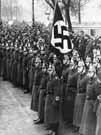
|
|
|

|

|

|

|
|
Click on an image to see a larger, more detailed picture.
|
|
|
|
|
| 1936: The Nazis |

|
pg. 105 |

|
|
|
|
| |
 In 1936 Heinrich Himmler was appointed head of Germany's police forces, a position that allowed him the tools necessary to carry out his race-based agenda. It also simultaneously placed fellow Nazi Hermann Göring in a subordinate position. Himmler was amassing tremendous powers. He was the lord of the Nazi concentration camp system and would become the second most powerful man in Germany during World War II.
In 1936 Heinrich Himmler was appointed head of Germany's police forces, a position that allowed him the tools necessary to carry out his race-based agenda. It also simultaneously placed fellow Nazi Hermann Göring in a subordinate position. Himmler was amassing tremendous powers. He was the lord of the Nazi concentration camp system and would become the second most powerful man in Germany during World War II.
Photo: The New York Times/United States Holocaust Memorial Museum Photo Archive
|
 A group of Jewish girls in Berlin participates in a vocational training course in anticipation of emigrating. By 1936 German Jews were deprived of an economic livelihood and encouraged to leave Germany. Though never official Nazi policy, the increased social isolation of Jews in the Reich, along with intensive economic discrimination, made it painfully clear that hopes for the future had to be realized in other countries.
A group of Jewish girls in Berlin participates in a vocational training course in anticipation of emigrating. By 1936 German Jews were deprived of an economic livelihood and encouraged to leave Germany. Though never official Nazi policy, the increased social isolation of Jews in the Reich, along with intensive economic discrimination, made it painfully clear that hopes for the future had to be realized in other countries.
Photo: Ruth Gross/Bildarchiv Abraham Pisarek, Berlin
|
 Creating a Police State
Creating a Police State
The Nazis realized that control of the police was vital to the regime's maintenance of power. By fusing the SS with all police forces in Germany, Heinrich Himmler was able to construct a police state based on coercion and terror. Responsible only to the Führer, Himmler circumvented legal systems and state bureaucracies. The Nazi police apparatus was free to define "legality," and was unhindered by moral constraints. Already chief of the SS, Himmler launched his quest for police power in 1933, becoming police president of Munich and then commander of the Bavarian political police. The following year he was appointed chief of political police in all German states, and also gained control of the Prussian Gestapo. Formally named chief of all German police in 1936, he restructured it into two main departments: Order Police, including municipal police and rural constabularies; and Security Police, comprising the Gestapo and the Criminal Police. Later, the Security Police and SD were amalgamated, thereby consolidating an astonishing amount of power. The Central Office for Reich Security, created in 1939, included numerous subdivisions of "preventive surveillance." As a result, a vast and diverse array of individuals and groups were under constant watch. Targets included Jews, Marxists, churches, and homosexuals, among others.
|
|

|

|

|

|
 June 17, 1936: Heinrich Himmler is appointed the chief of German police.
June 17, 1936: Heinrich Himmler is appointed the chief of German police.
|
 June 19, 1936: German heavyweight boxer Max Schmeling, a former world champion, defeats promising African-American heavyweight Joe Louis. Hitler turns the fight into a propaganda victory for Aryan superiority; See June 22, 1938.
June 19, 1936: German heavyweight boxer Max Schmeling, a former world champion, defeats promising African-American heavyweight Joe Louis. Hitler turns the fight into a propaganda victory for Aryan superiority; See June 22, 1938.
|
 June 26, 1936: Reinhard Heydrich is appointed by Heinrich Himmler to head the SD (Security Service branch of the SS).
June 26, 1936: Reinhard Heydrich is appointed by Heinrich Himmler to head the SD (Security Service branch of the SS).
|
 June 30, 1936: Polish Jews strike to protest antisemitism.
June 30, 1936: Polish Jews strike to protest antisemitism.
|
 July 3, 1936: German Jew Stefan Lux kills himself in the assembly room of the League of Nations in Geneva, Switzerland. The suicide is in protest of Germany's persecution of Jews.
July 3, 1936: German Jew Stefan Lux kills himself in the assembly room of the League of Nations in Geneva, Switzerland. The suicide is in protest of Germany's persecution of Jews.
|
|
|
|
|
| 1936: The Nazis |

|
pg. 105 |

|
|
The Holocaust Chronicle
© 2009 Publications International, Ltd.
|
|
